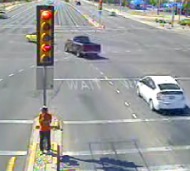12/14/2009
Federal Agency Rules Traffic Camera Enforcement Lines IllegalFederal agency declares use of red light camera stop lines to be illegal and potentially unsafe.

The Federal Highway Administration (FHWA) last month issued an official ruling that found red light camera "violation lines" illegal. A number of jurisdictions across the country paint four-inch wide white lines on the pavement at what is known as the "prolongation" of the cross street's curb line in order to facilitate the use of automated ticketing machines. These are not the "stop bar" or crosswalk lines that most motorists expect, but a third set of lines that appear at the very edge of the intersection.
When Arizona motorist Dianne Patterson asked FHWA whether the city of Tucson violated the law by using violation lines, FHWA's Acting Director of Transportation Operations, Paul Pisano, said it did.
"The Manual on Traffic Control Devices (MUTCD) does not contain any provisions for the use of transverse lines to indicate the legal limits of an intersection for red light violation purposes," Pisano wrote. "The reason is that, under the provisions of the Uniform Vehicle Code, which is the basis of the motor vehicle laws of most states, the stop line, or crosswalk if there is no stop line, defines the point beyond which a red light violation has occurred."
Federal law regulates the use of traffic signs and markings on all roads to ensure consistency in the driving experience from one end of the country to the other. Signs and markings must adhere to standards set by the MUTCD governing size, color, placement and even the choice of font. FHWA found that unapproved markings could create a safety hazard, especially the use of the word "WAIT" before the violation line at Oracle Road and River Road (see red light camera ticket photo, and overhead diagram with the violation line highlighted in red).
"It is unlikely that drivers from other states who encounter these markings in Arizona would understand their meaning or intent," Pisano wrote. "The word marking 'WAIT,' although technically not disallowed by the MUTCD, is of particular concern because it is visible to drivers at all times even though it does not apply at all times. When the signal is displaying circular green or green arrow indications, the 'WAIT' message could be confusing and could provoke unfamiliar drivers to stop unexpectedly at the violation line."
Chad Dornsife, Executive Director of the Best Highway Safety Practices Institute told TheNewspaper that use of the violation line was an intentionally deceptive practice.
"The second white line is an enforcement trap," Dornsife said. "It's the worst kind of trap because those that hesitate to make sure it is safe will get a citation, and the set back is back so far that even if you have a clear path you cannot clear the intersection in time."
At the Oracle location, for example, the violation line appears forty-three feet after the stop bar. This means a driver who clears the crosswalk on yellow would still get a ticket if he did not clear the violation line before the light turned red. At 40 MPH, the practice has the same effect on violations as shortening the yellow light by 1.3 seconds.
FHWA officials emphasized that safety was their primary concern in issuing the ruling. The agency is open to modifying its regulations, but only after strict procedures have been followed to ensure the changes do not undermine safe driving practices.
"Jurisdictions wishing to use such non-compliant markings or devices are required by Section 1A.10 of the MUTCD to request and receive approval from the Federal Highway Administration for experimentation," Pisano wrote. "Such experimentation would necessarily include data collection and study to evaluate road users' understanding of the markings, the effectiveness of such markings in reducing violations, and whether such markings create other safety issues."
Arizona is far from alone in using illicit pavement markings in photo enforcement programs. In 2007, Garland, Texas was found to have used violation lines contrary to the definitions found in state law.
View a copy of the FHWA ruling in a 90k PDF file at the source link below.


